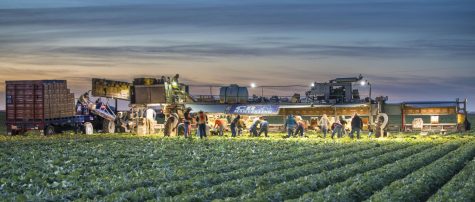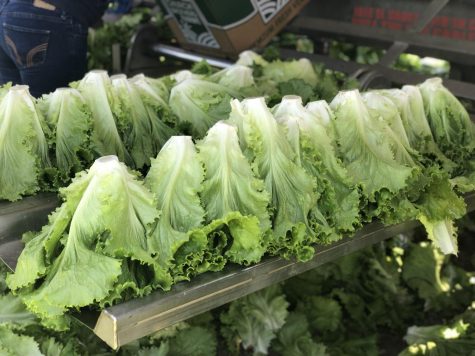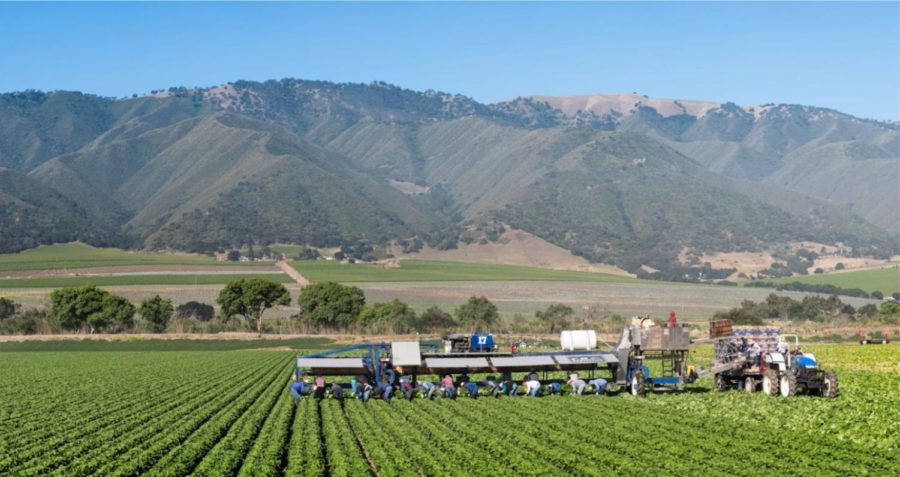From the farm
Exploring the people who harvest and deliver ingredients used to cook MVHS’s meals
Church Brothers Farms
One of the farms managed by the Church Brothers Farms company – a company that harvests and sources produce to venues and corporations.
December 9, 2022
“There’s always somebody [at the warehouse],” Chef’s Choice Produce manager Bob Menafra said. “Trucks [come] in at seven o’clock at night and work ‘til about three in the morning. The drivers start showing up anywhere from one in the morning to five in the morning. Their trucks are loaded and they hit the road. When you sit down [and] look at your salad or strawberries or whatever, there’s a lot behind it.”

Chef’s Choice Produce — a local produce company based in Santa Clara, California — is one of several food companies that source produce to MVHS. According to Menafra, Chef’s Choice delivers food products stored in their warehouses to schools, restaurants and even wedding venues.
In addition to delivering produce, Menafra explains that Chef’s Choice also sources fresh produce from several farms depending on the season. For example, due to the cold and rain in California in fall and winter, Menafra says that produce sourcing moves to Arizona and Mexico. The process of providing food to MVHS begins at farms. Church Brothers Farm, based in the Salinas Valley of California, is one of the farms from which companies like Chef’s Choice source produce.

“Our founders have a long history of farming in the Salinas Valley, beginning in the ‘50s with Bruce Church Company, the founding father of large-scale commercial farming,” Krnic said in an email. “Church Brothers Farms was established in 1999 and has flourished ever since. Our founders grew up in this industry and were inspired by their roots.”
Church Brothers Farm harvests produce such as broccoli, cauliflower, romaine lettuce, iceberg lettuce, spinach and spring mix. Its processing facility then cuts, triple washes and dries its products.
Marketing Manager of Church Brothers Farm Sasha Krnic explains that many thorough steps are involved in managing over 45,000 acres of their farm. According to Krnic, one of the most important aspects of farming is walking around the ranch several times per week to assess the crop quality and ensure the harvest is on schedule. Regarding the overall production, the Church Brothers team attends planning and planting meetings, monitors harvest operations, conducts seed trials and assesses food safety processes.

After being harvested at farms such as Church Brothers, the produce then makes its way to produce companies such as Chef’s Choice Produce.
Chef’s Choice provides delivery services six days a week. Menafra’s days at the warehouse typically begin at around 5 a.m. and end at around 4 p.m. Menafra and other employees work to ensure that deliveries arrive on time. He oversees orders from farms and brokers, manages customer service interactions and addresses potential issues, while occasionally helping unload trucks and conduct quality checks on produce.
Menafra entered the produce managing business after working as a restaurant manager for 16 years. After deciding he needed to switch professions to increase his income and skill set, Menafra transitioned into the produce company and has been working in the business for 26 years.
Currently, one problem that Menafra notes is shipping, due to the exceedingly high prices of fuel and transportation. Another issue for Menafra is the California weather, which sometimes causes produce to become unavailable when items are rained out. From a harvesting perspective, the weather also poses a challenge. Krnic explains that the changing climate leads Church Brothers to farm in different states, depending on the season.
“The weather is a major challenge — it can be either your friend or your enemy in this industry,” Krnic said. “Throughout the whole valley, farmers will experience issues caused by rain, insect pressure, diseases and labor.”
In response to these concerns, Krnic’s main goal is to drive down the cost of their operation by “stretching every dollar spent on the farm.” She hopes to do this by focusing on automation-related projects and exploring new seed varieties.
Following the storage of produce at warehouses, delivery drivers facilitate the transportation of the food to schools. Chef’s Choice delivery driver Rosalio Lara is one of many drivers who transport food from the warehouse to MVHS. On a typical day of delivery, Lara starts his deliveries at 3 a.m. and makes between 10 and17 stops, delivering foods such as strawberries, bananas, meats and tomatoes to schools.
Having spent over 30 years working as a delivery driver, Lara explains how the experience has helped him easily identify boxes, which makes the process faster. Lara became a delivery driver when he was 20 years old when his brother-in-law helped him find the job. In order to become a delivery driver, Lara spent two weeks learning how to identify different types of produce and herbs.
Although Lara’s job requires him to start work early and at odd hours, he finds driving to be the most rewarding part because “on the road you breathe, you see and you’re by yourself.”
“I enjoy delivering everywhere because I have friends who sign the invoices, and we talk about the produce [and we] talk about our family,” Lara said. “It is fun to deliver everywhere. I’m happy delivering produce.”
Similarly, Menafra finds his job rewarding and enjoys the sense of accomplishment in knowing that his job benefits others.

“We deliver to catering companies that are counting on us to be able to produce for people’s weddings and that kind of [thing],” Menafra said. “It’s nice when you’re able [to] know that you’ve gone to work and helped other people get their job done.”
Transporting produce from farms to warehouses to schools is the first step in making the food served at MVHS. Ultimately, for Krnic, the most important part of her job is seeing satisfied customers.
“We operate in a trust business, so relationships and communication are key,” Krnic said in an email. “We are trusted to produce great tasting and safe products every single day. On a greater level, the most rewarding part of our business is feeding people. We are proud to supply fresh, healthy food to the entire nation— it is [both] fulfilling and humbling.”
This story was originally published on El Estoque on November 17, 2022.



























![IN THE SPOTLIGHT: Junior Zalie Mann performs “I Love to Cry at Weddings,” an ensemble piece from the fall musical Sweet Charity, to prospective students during the Fine Arts Showcase on Wednesday, Nov. 8. The showcase is a compilation of performances and demonstrations from each fine arts strand offered at McCallum. This show is put on so that prospective students can see if they are interested in joining an academy or major.
Sweet Charity originally ran the weekends of Sept. 28 and Oct. 8, but made a comeback for the Fine Arts Showcase.
“[Being at the front in the spotlight] is my favorite part of the whole dance, so I was super happy to be on stage performing and smiling at the audience,” Mann said.
Mann performed in both the musical theatre performance and dance excerpt “Ethereal,” a contemporary piece choreographed by the new dance director Terrance Carson, in the showcase. With also being a dance ambassador, Mann got to talk about what MAC dance is, her experience and answer any questions the aspiring arts majors and their parents may have.
Caption by Maya Tackett.](https://bestofsno.com/wp-content/uploads/2024/02/53321803427_47cd17fe70_o-1-1200x800.jpg)
![SPREADING THE JOY: Sophomore Chim Becker poses with sophomores Cozbi Sims and Lou Davidson while manning a table at the Hispanic Heritage treat day during lunch of Sept 28. Becker is a part of the students of color alliance, who put together the activity to raise money for their club.
“It [the stand] was really fun because McCallum has a lot of latino kids,” Becker said. “And I think it was nice that I could share the stuff that I usually just have at home with people who have never tried it before.”
Becker recognizes the importance of celebrating Hispanic heritage at Mac.
“I think its important to celebrate,” Becker said. “Because our culture is awesome and super cool, and everybody should be able to learn about other cultures of the world.”
Caption by JoJo Barnard.](https://bestofsno.com/wp-content/uploads/2024/01/53221601352_4127a81c41_o-1200x675.jpg)















